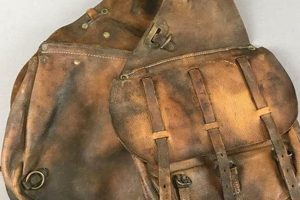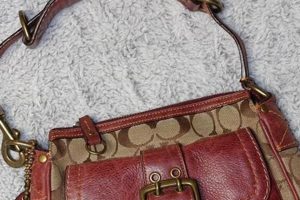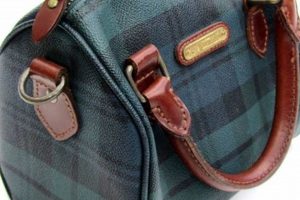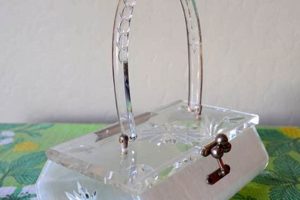Classic American leather goods, particularly those produced by Dooney & Bourke in earlier decades, have garnered significant attention in recent years. These pre-owned accessories, characterized by their durable construction and distinctive designs, represent a specific segment of the pre-owned handbag market. Examples include the All-Weather Leather collection and bags featuring signature duck motifs, easily identifiable through their materials, hardware, and branding.
The resurgence in popularity of these items is driven by factors such as enduring quality and nostalgic appeal. Many value the craftsmanship inherent in vintage pieces and the opportunity to acquire well-preserved examples of past styles. The brand’s reputation for producing resilient, long-lasting products contributes significantly to the desirability of older models. This interest also reflects broader trends towards sustainable consumption and the appreciation of items with established histories.
This article will delve into the specific characteristics of these sought-after handbags, providing guidance on identification, assessment of condition, and an overview of popular styles. This will provide prospective buyers and enthusiasts with a deeper understanding of this distinct category of accessories.
Essential Considerations for Acquiring Classic Dooney & Bourke Handbags
Evaluating the authenticity and condition of these pre-owned accessories requires careful examination. The following guidelines are intended to assist in informed purchasing decisions.
Tip 1: Authenticate the Bag’s Origin: Examine the interior tags or labels. Early Dooney & Bourke bags typically feature a sewn-in red, white, and blue tag with a serial number. Research the serial number to verify its consistency with known manufacturing patterns and dates. Inconsistencies may indicate a counterfeit.
Tip 2: Assess the Leather Quality: All-Weather Leather, a hallmark of the brand, is known for its durability and water resistance. Check for signs of excessive wear, cracking, or stiffness, which may impact the bag’s long-term usability. Minor scuffs and patina are common in vintage items, but significant damage warrants careful consideration.
Tip 3: Inspect the Hardware: Brass hardware is frequently used in authentic bags. Examine buckles, clasps, and zippers for corrosion, damage, or missing components. Ensure that all hardware functions correctly and matches the style and era of the handbag.
Tip 4: Evaluate Stitching and Construction: Dooney & Bourke bags are recognized for their quality craftsmanship. Assess the stitching for uniformity, tightness, and any signs of unraveling. Check the seams for tears or separation. Uneven stitching or poorly constructed seams may suggest a lack of authenticity or substandard repairs.
Tip 5: Consider the Bag’s Overall Condition: Assess the interior lining for stains, tears, or odors. Thoroughly inspect all pockets and compartments. The presence of significant damage or unpleasant odors may detract from the bag’s value and usability.
Tip 6: Research the Bag’s Style: Familiarize yourself with the various styles and models produced by Dooney & Bourke over the years. This knowledge will aid in identifying the bag’s age, rarity, and potential value. Consult reputable online resources and vintage handbag guides for information.
Tip 7: Compare Prices: Research the market value of similar bags in comparable condition. Factor in the bag’s style, age, and rarity when determining a fair price. Be wary of prices that seem significantly lower than market value, as this could indicate a counterfeit or a bag with undisclosed flaws.
Careful assessment of these factors will enable buyers to make more confident and informed decisions when acquiring these enduring accessories.
The next section will explore the care and maintenance of classic Dooney & Bourke bags to preserve their value and extend their lifespan.
1. Construction Materials
The composition of materials used in the manufacture of vintage Dooney & Bourke handbags is a defining characteristic that significantly impacts their longevity, aesthetic appeal, and market value. The selection of materials, primarily leather, hardware, and linings, reflects the brand’s commitment to durability and timeless design.
- All-Weather Leather
All-Weather Leather (AWL) is a signature material associated with the brand’s vintage collections. This specially treated leather is known for its water resistance and robust nature. Bags constructed with AWL exhibit resilience against the elements and resist wear and tear, contributing to their longevity. The tanning process and finishing techniques employed on AWL produce a distinct texture and patina over time, making each bag unique. The presence and condition of AWL are primary factors in determining the desirability of a vintage bag.
- Brass Hardware
Solid brass hardware is a common feature in authentic vintage Dooney & Bourke bags. Brass buckles, clasps, zippers, and studs contribute to the bag’s structural integrity and aesthetic appeal. Brass is chosen for its strength, corrosion resistance, and ability to develop a rich patina over time. The presence of solid brass hardware, its condition, and its style are key indicators of authenticity and contribute to the bag’s overall value. Replacement hardware or damage to the original brass components can negatively impact the bag’s value.
- Textile Linings
The interior linings of vintage Dooney & Bourke bags often consist of durable cotton or canvas fabrics. These linings provide structural support and protection for the bag’s contents. The color and texture of the lining are often specific to certain styles and production periods, offering clues to the bag’s age and authenticity. Tears, stains, or odors within the lining can detract from the bag’s overall condition and value. The integrity of the lining is a crucial aspect of assessing the bag’s usability and collectibility.
- Stitching and Thread
The type and quality of stitching used in the construction of vintage Dooney & Bourke bags are essential elements of their durability and aesthetic appeal. High-quality thread, typically nylon or polyester, is employed to create strong, consistent seams. Uniform stitch length and tight thread tension are hallmarks of well-crafted bags. Broken or uneven stitching can indicate poor construction or repairs, which may negatively affect the bag’s structural integrity and value. The pattern and color of the stitching also offer clues to the bag’s authenticity and production period.
In summary, the specific materials used in vintage Dooney & Bourke handbags, particularly the All-Weather Leather, solid brass hardware, durable textile linings, and robust stitching, play a critical role in their enduring appeal and value. Identifying and assessing these construction elements is essential for both collectors and potential buyers.
2. Hardware Identification
The precise identification of hardware components is a critical aspect in evaluating the authenticity, age, and overall condition of Dooney & Bourke vintage bags. The brand historically utilized specific types of brass, closures, and detailing, providing valuable clues to a bag’s provenance. For instance, early models often feature solid brass duck fobs and distinctive brass rivets, while later variations may exhibit subtle differences in the shape, size, and finish of these elements. Accurate hardware identification can expose inconsistencies indicative of counterfeiting or unauthorized repairs, thereby affecting the item’s value and collectibility. Examples include discrepancies in zipper pulls, which vary across production years, and the presence of non-brass components where solid brass was originally used.
Beyond authentication, hardware assessment informs condition analysis. The presence of corrosion, wear patterns, or missing elements provides insights into the bag’s storage history and usage. A bag with heavily corroded brass may indicate prolonged exposure to moisture, potentially affecting the leather. Similarly, mismatched or replaced hardware significantly diminishes value, as originality is highly prized in the vintage market. Correct identification also facilitates appropriate restoration efforts, enabling the use of compatible replacement parts when necessary. For instance, knowing the exact type of brass clasp allows for sourcing a functionally and aesthetically consistent replacement, preserving the bag’s integrity.
In conclusion, hardware identification is an indispensable skill for collectors and buyers of Dooney & Bourke vintage bags. It serves as a primary means of authentication, a crucial component in condition assessment, and a facilitator of appropriate restoration. Challenges in hardware identification arise from the subtle variations across production periods and the prevalence of counterfeit parts. However, a detailed understanding of historical hardware specifications remains essential for making informed purchasing decisions and preserving the value of these classic accessories.
3. Serial Number Verification
Serial number verification is a critical process in authenticating Dooney & Bourke vintage bags. The serial number, typically found on a small leather tag sewn inside the bag, serves as a unique identifier linked to production details. This alphanumeric code can provide insight into the bag’s manufacturing date, style, and materials. A discrepancy between the serial number and known production characteristics of genuine bags often indicates a counterfeit item. For example, a serial number format inconsistent with those used during a specific era, or a code that fails to correspond to the bag’s stated style, raises immediate concerns about its authenticity.
The importance of serial number verification extends beyond simply identifying fakes. It also facilitates the accurate assessment of a bag’s value and rarity. Certain serial number sequences may correspond to limited edition releases or styles produced only during specific periods, making those bags more desirable to collectors. Furthermore, accessing databases or expert resources that cross-reference serial numbers with known production data allows for a more informed understanding of the bag’s history and composition. An example is the availability of online forums and collector communities dedicated to compiling information on Dooney & Bourke serial numbers, providing valuable verification resources.
Despite its importance, serial number verification is not foolproof. Counterfeiters have become increasingly sophisticated in replicating serial number formats, requiring careful attention to detail when assessing a bag’s authenticity. Furthermore, damaged or missing serial number tags can present a challenge. The absence of a serial number does not automatically condemn a bag as fake, but it does necessitate a more rigorous examination of other authentication factors, such as hardware, stitching, and leather quality. In conclusion, while serial number verification is a crucial tool, it must be used in conjunction with other authentication methods to ensure the accurate assessment of Dooney & Bourke vintage bags.
4. Style Period Recognition
Style period recognition represents a critical skill for assessing the authenticity, value, and historical significance of Dooney & Bourke vintage bags. Accurately identifying the era in which a bag was produced provides valuable context regarding its design, materials, and construction techniques, enabling informed purchasing and collection management decisions.
- Identifying Key Design Elements
Each era of Dooney & Bourke production is characterized by distinct design elements, including specific silhouettes, hardware styles, and logo placements. For example, the early All-Weather Leather (AWL) bags from the 1980s and 1990s often feature equestrian-inspired designs, such as the equestrian bag or courier bag, easily recognized by their flap closures and adjustable straps. Recognizing these period-specific design cues aids in narrowing down a bag’s production timeframe.
- Material Composition and Hardware Variations
The types of materials used, particularly the leather and hardware, evolved over time. Early bags predominantly feature All-Weather Leather and solid brass hardware. Later productions may incorporate variations in leather texture or introduce alternative hardware finishes. Discrepancies between the materials used and the known materials for a specific period can indicate authenticity issues or subsequent modifications. Identifying these shifts requires familiarity with the brand’s historical material specifications.
- Logo and Branding Evolution
The Dooney & Bourke logo underwent several iterations throughout its history. Early bags typically feature a prominent duck logo, either embossed on the leather or present as a metal fob. Later versions may incorporate a different font or logo placement. Recognizing these variations provides clues to the bag’s age. For example, a bag featuring a logo style not introduced until the 2000s cannot be a vintage item from the 1980s.
- Interior Tag and Serial Number Decoding
Interior tags and serial number formats also changed over time. Early bags feature a red, white, and blue tag with a specific serial number format. Later productions may use different tag colors or introduce variations in the serial number structure. Decoding these codes enables a precise determination of the bag’s production year. Consulting online resources and collector guides that document these changes is essential for accurate style period recognition.
By mastering style period recognition, collectors and buyers can more effectively assess the authenticity, value, and historical significance of Dooney & Bourke vintage bags. This skill combines knowledge of design history, material science, and branding evolution, enabling informed decisions in the vintage handbag market.
5. Condition Assessment
The evaluation of condition constitutes a pivotal step in the acquisition and valuation of Dooney & Bourke vintage bags. The state of preservation directly affects the item’s usability, aesthetic appeal, and monetary worth. Factors such as leather integrity, hardware functionality, presence of stains or odors, and structural soundness contribute to the overall condition grade. A bag exhibiting minimal wear, intact stitching, and well-preserved hardware commands a higher market price, exemplifying the direct correlation between condition and value. Conversely, significant damage, such as cracked leather, broken zippers, or pervasive odors, diminishes the bag’s desirability and potentially renders it unusable.
Practical application of condition assessment extends beyond mere visual inspection. A thorough evaluation involves tactile examination of the leather to identify dryness, stiffness, or cracking. Hardware should be tested for smooth operation and assessed for corrosion. Interior linings warrant scrutiny for staining, tearing, or odors, which can be indicative of past storage conditions. Accurate assessment informs restoration decisions. Minor blemishes may be addressed with appropriate leather treatments, while more substantial damage might necessitate professional repair. For example, the replacement of a broken zipper with a period-appropriate component preserves the bag’s authenticity while restoring functionality.
The inherent subjectivity in condition grading presents a challenge. Terms such as “excellent,” “good,” and “fair” are open to interpretation, potentially leading to discrepancies between seller claims and buyer expectations. Standardized grading systems, while not universally adopted, provide a more objective framework for condition assessment. Furthermore, detailed photographs and transparent disclosure of any flaws or repairs are essential for fostering trust in online transactions. Ultimately, a comprehensive understanding of condition assessment principles empowers buyers to make informed decisions and ensures the preservation of these classic accessories.
Frequently Asked Questions
The following questions address common inquiries regarding the acquisition, authentication, and care of vintage handbags produced by Dooney & Bourke.
Question 1: How can the authenticity of a vintage Dooney & Bourke bag be verified?
Authenticity verification involves several steps, including examining the presence and format of the serial number, scrutinizing the quality and style of hardware, and assessing the type and condition of leather used. Comparison with known characteristics of genuine bags from the period in question is crucial.
Question 2: What factors contribute to the valuation of a vintage Dooney & Bourke bag?
Valuation is influenced by condition, rarity, style period, and the presence of original components. Bags in excellent condition, featuring desirable styles from specific eras, and retaining original hardware and accessories command higher prices.
Question 3: What are the key indicators of damage in vintage Dooney & Bourke All-Weather Leather?
Indicators of damage include cracking, stiffness, discoloration, and excessive wear. All-Weather Leather is designed for durability, but prolonged exposure to harsh conditions can compromise its integrity.
Question 4: What is the recommended method for cleaning vintage Dooney & Bourke All-Weather Leather?
Cleaning should be performed with a mild, pH-neutral soap and water solution, applied with a soft cloth. Harsh chemicals and abrasive cleaners should be avoided to prevent damage to the leather. Professional leather cleaning is advisable for significant staining or soiling.
Question 5: How should vintage Dooney & Bourke bags be stored to prevent deterioration?
Proper storage involves protecting the bag from direct sunlight, moisture, and extreme temperatures. Storage in a dust bag, with stuffing to maintain its shape, is recommended. Leather conditioners should be applied periodically to prevent drying and cracking.
Question 6: Can replaced hardware affect the value of a vintage Dooney & Bourke bag?
Yes, the presence of non-original or mismatched hardware can significantly reduce the value of a vintage bag. Original hardware is a key indicator of authenticity and contributes to the bag’s historical integrity.
These FAQs offer foundational guidance for navigating the complexities of the vintage Dooney & Bourke handbag market.
The next section will focus on resources for further research and expert appraisal.
Conclusion
The preceding analysis has illuminated key facets of the pre-owned market for leather accessories manufactured by Dooney & Bourke in prior decades. Accurate authentication, condition assessment, and style period recognition are essential skills for navigating this market effectively. Factors such as material composition, hardware characteristics, and serial number verification play a pivotal role in determining the value and collectibility of these items.
The enduring appeal of these handbags reflects a confluence of factors, including the brand’s reputation for quality craftsmanship and the growing interest in sustainable consumption practices. Continued diligence in authentication and preservation will ensure the longevity and appreciation of these classic accessories for future generations. The responsibility falls upon collectors and enthusiasts to maintain the integrity of this segment of the market.







